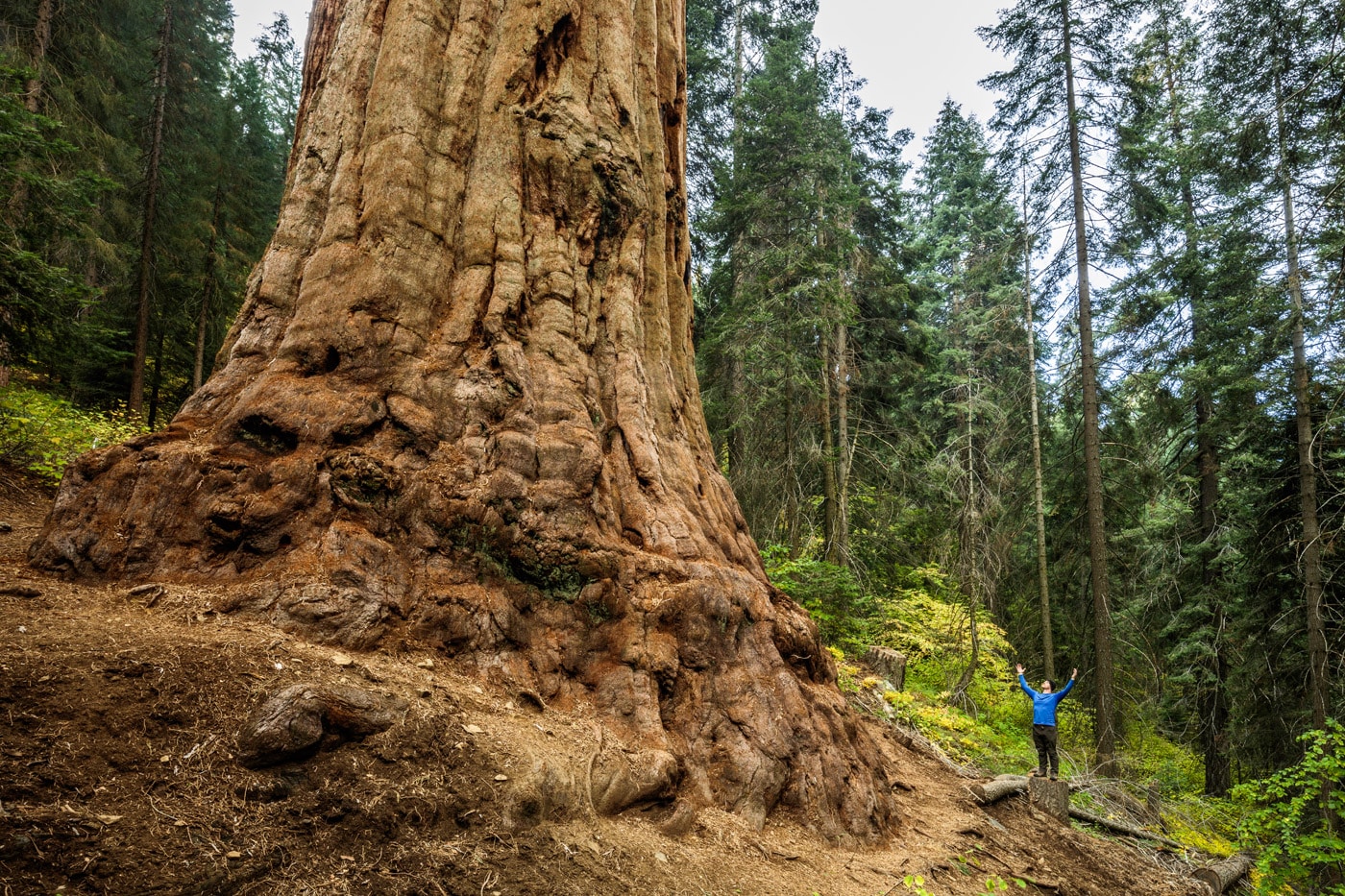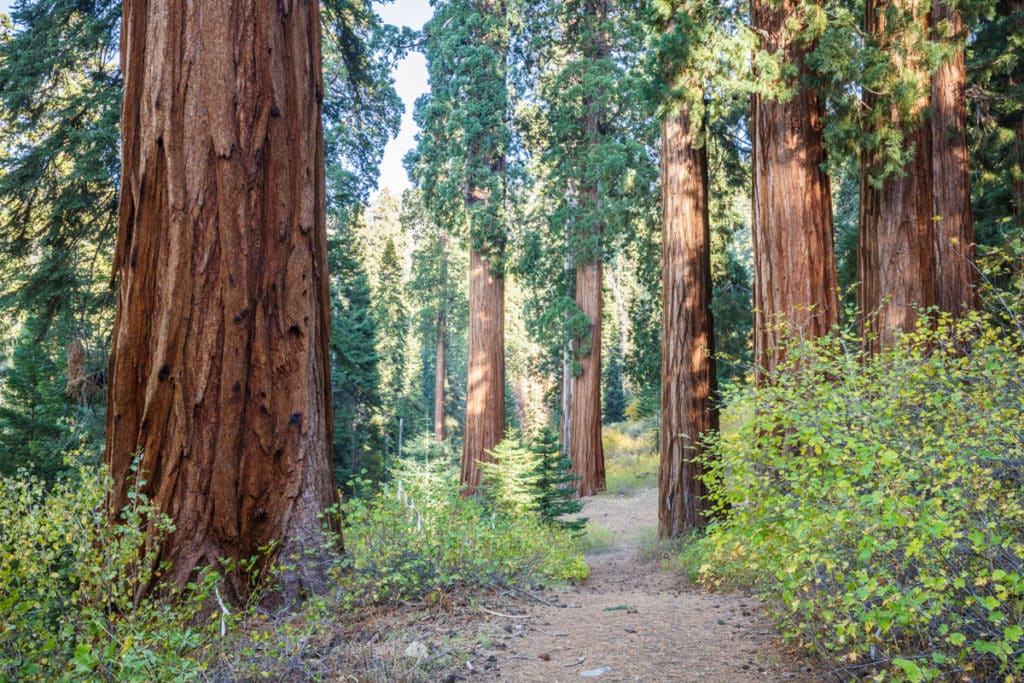Protecting an extraordinary giant forest

You’re constantly looking skyward when exploring Alder Creek. The property’s monumental trees demand it. This land supports hundreds of old-growth giant sequoias, making it comparable in size and significance to the famous Mariposa Grove of Giant Sequoias in Yosemite National Park.
Save the Redwoods League acquired the property in December 2019 for $15.65 million, following a spectacular four-month public fundraising campaign. The League received more than 8,500 contributions from individuals and foundations from across the United States and 30 other countries worldwide. We are also raising additional funds for ongoing stewardship.
Alder Creek’s trove of giant sequoias includes the fifth-largest known tree in the world as measured by volume: the Stagg Tree, a mighty behemoth that’s likely thousands of years old. At 250 feet tall, it’s the largest tree in the Giant Sequoia National Monument, wider than a two-lane street and as tall as a 25-story skyscraper. But arguably the most important aspect of the property is its ancient landscape—a snapshot of a wild California that is rarely seen these days.
Conservation in the giant sequoia heartland

Giant sequoia forests are one of the rarest ecosystems on the planet, encompassing merely 25,000 acres. Although most of it is in conservation ownership, it is vital to secure as much as we can, because every inch of this ancient, resilient, carbon-storing, and inspiring forest is irreplaceable.
The Alder Creek property is bordered on three sides by the Giant Sequoia National Monument, the heartland for giant sequoia. At 328,000 acres, the monument is a scenic, recreational, and scientific treasure of incalculable value. It contains more than 45% of the world’s giant sequoia trees and is a key component in the long-term conservation strategy for all giant sequoias and the rare and imperiled species that coexist with them. Alder Creek provides habitat for animals including Pacific fisher, American marten, and California spotted owl.
Alder Creek, the waterway for which the property was named, runs through the northern portion of the land, offering an abundant water source and rich habitat for local fish and wildlife. The property contains robust stands of mature red fir, white fir, ponderosa pine, and sugar pine, as well as several other habitats, including meadows, wetlands, and riparian woodlands. Each sustains a unique suite of associated species; together, they form a vital and resilient ecosystem emblematic of the southern Sierra Nevada and California.
Recovering from the Castle Fire and restoring wildfire resilience

In September 2020, the Castle Fire, part of the SQF Complex Fire, reached Alder Creek. While the majority of the property burned at low to moderate severity, roughly 38% burned at high severity, killing at least 108 large, old-growth giant sequoias and numerous firs and pines. Within these high-severity areas, fire consumed cones and seeds and damaged the soil, putting this area at risk of converting from a forest to a shrub-dominated landscape—a process called ecological type conversion.
Recognizing this threat to the next generation of sequoias, the League and our partners in the Giant Sequoia Lands Coalition have embarked on a reforestation strategy. The goals of this approach are to restore a resilient and diverse forest by reducing the density of dead trees and replanting the area with native tree species to promote a mature forest in the future. The League’s restoration goal is to bring back a balance of native forest species that have been altered by historical logging and fire suppression, reduce fuel loads to assure fire resilience and long-term protection, prepare the forest for warmer and drier conditions caused by climate change, and ease recovery from the 2020 Castle Fire.
In the areas of low- to moderate-severity fire, the League is prioritizing restoration work to reduce the risk of future severe wildfires at Alder Creek and prepare these areas to be more resilient to the effects of climate change . Although many parts of the property were well maintained by the previous landowners, some areas had not had any fire or thinning for several decades, resulting in an unnaturally dense understory that can contribute to severe fires. Restoration activities in these areas may include thinning and prescribed fire. This fuels reduction work also will open the forest canopy, providing giant sequoias with the sunlight and bare forest floor they require to thrive.
Unlike many sequoia groves, Alder Creek has giant sequoias in all age classes. By removing some of the smaller non-sequoia trees and reintroducing frequent, low-intensity fire, we can both reduce fire risk and help perpetuate the next generation of giant sequoias.
A living laboratory

We’ve learned a lot about giant sequoias and the ecosystems they support, but there’s still so much to learn. Among the most important uses of Alder Creek is for scientific research—it is a living laboratory for studying the plants and animals that call this dynamic ecosystem home. Save the Redwoods League conducts research on the property and offers research opportunities to other nonprofits and academic institutions.
In 2021, the League partnered with UC Cooperative Extension in a long-term study to understand different planting densities of giant sequoia seedlings and restoration methods following high-severity wildfire. In 2023, as part of the study, we planted over 20,000 sequoia seedlings in pre-determined densities on the property. These seedlings continue to do well and many are now 2 feet tall. This results of this research will ultimately inform our ongoing stewardship of the property and stewardship of other sequoia groves throughout the range.
Sequoia stewardship and public access at Alder Creek are part of the League’s efforts to build healthier forests and stronger communities across the redwood range. Your contributions to the Redwood Resilience Fund are an investment this future.
The tomorrow we want? It begins by taking action today.
Tags: Alder Creek